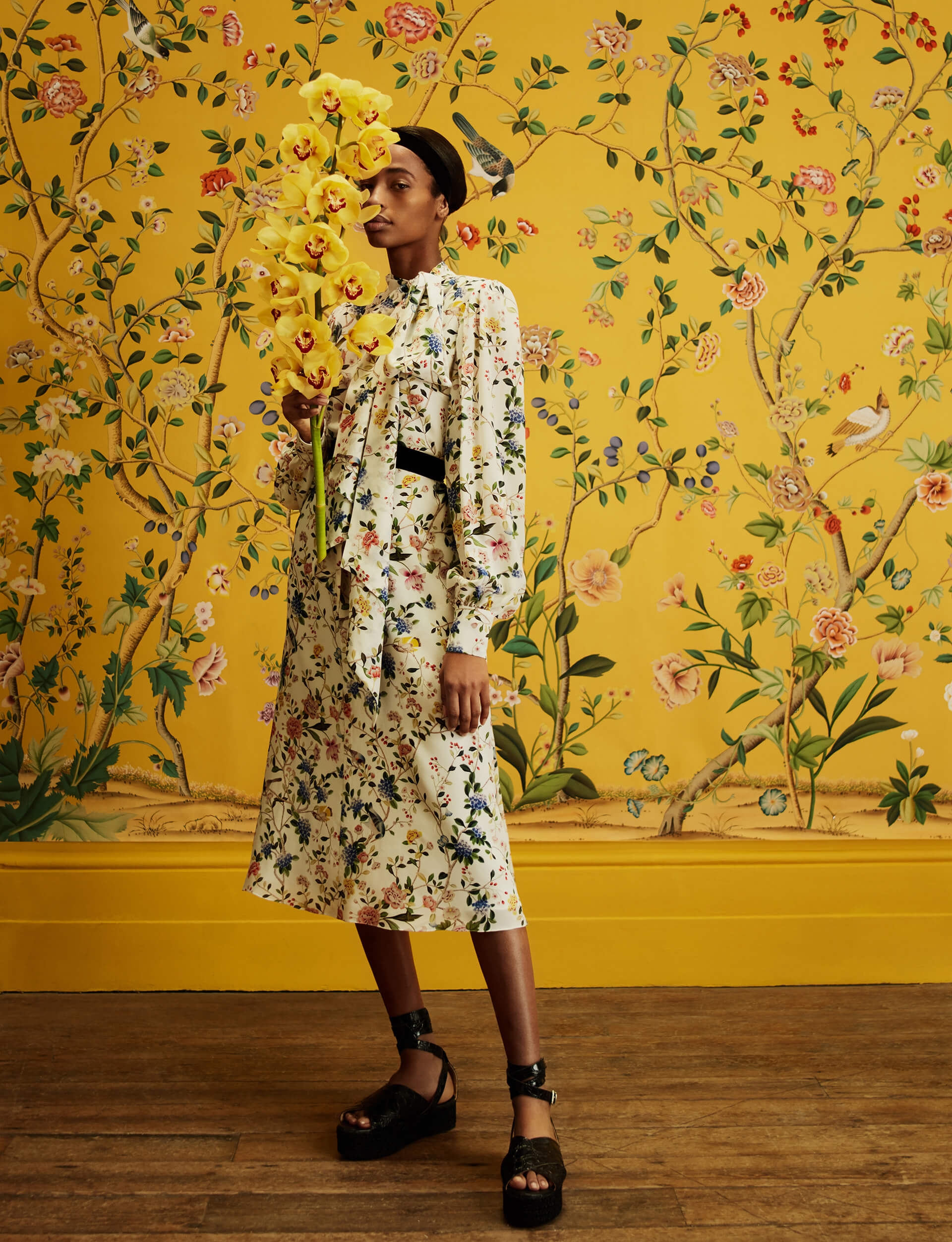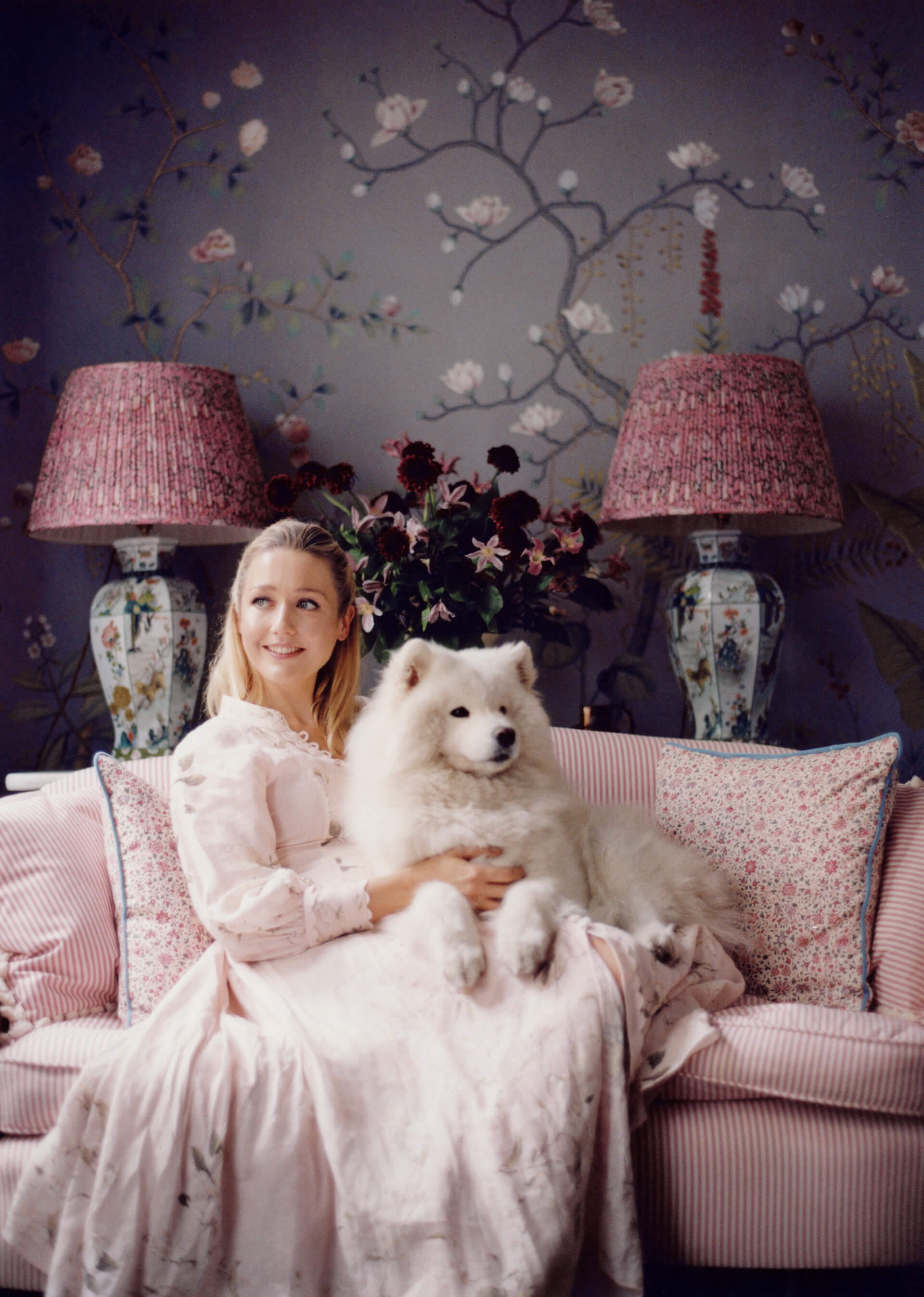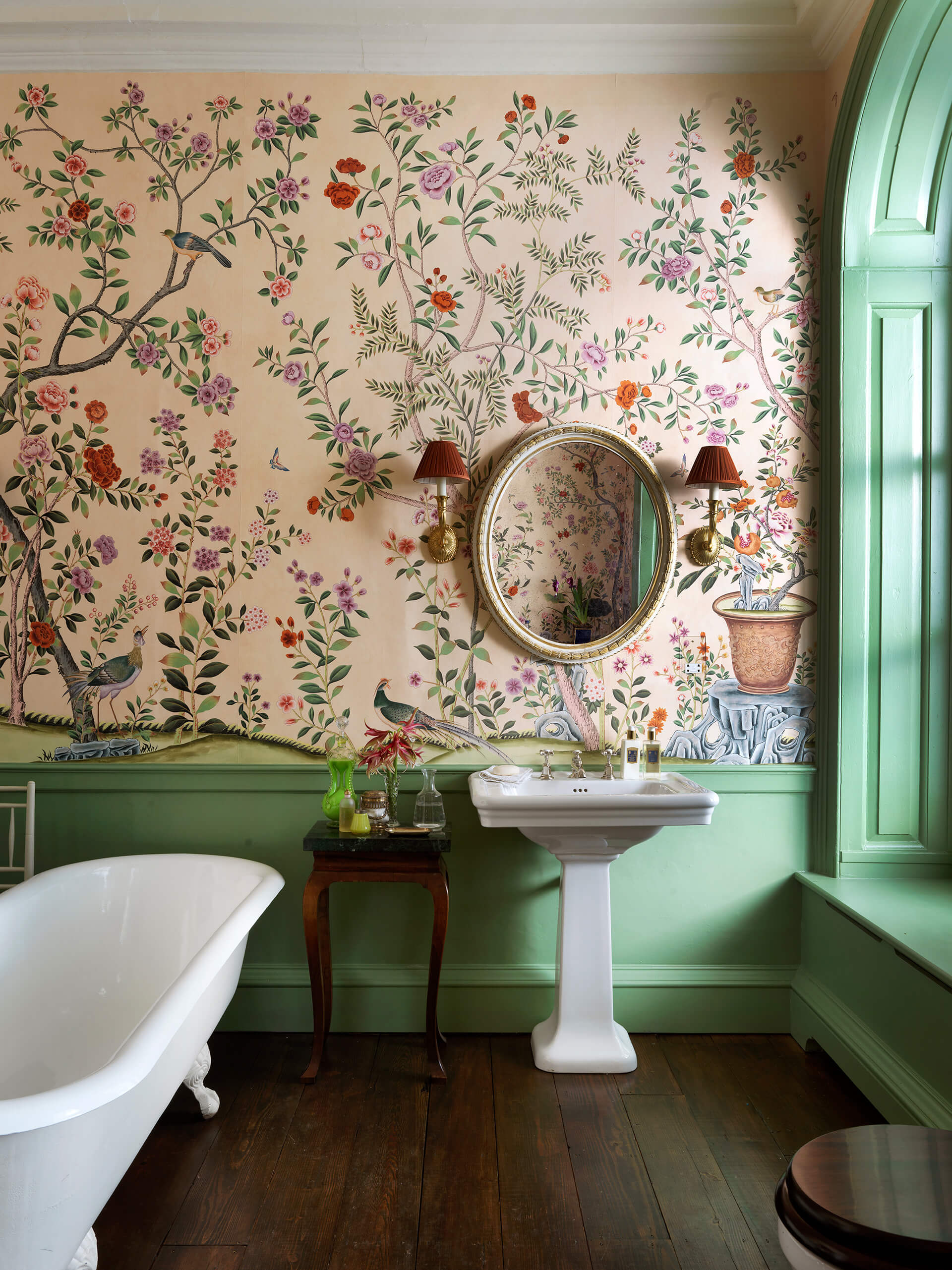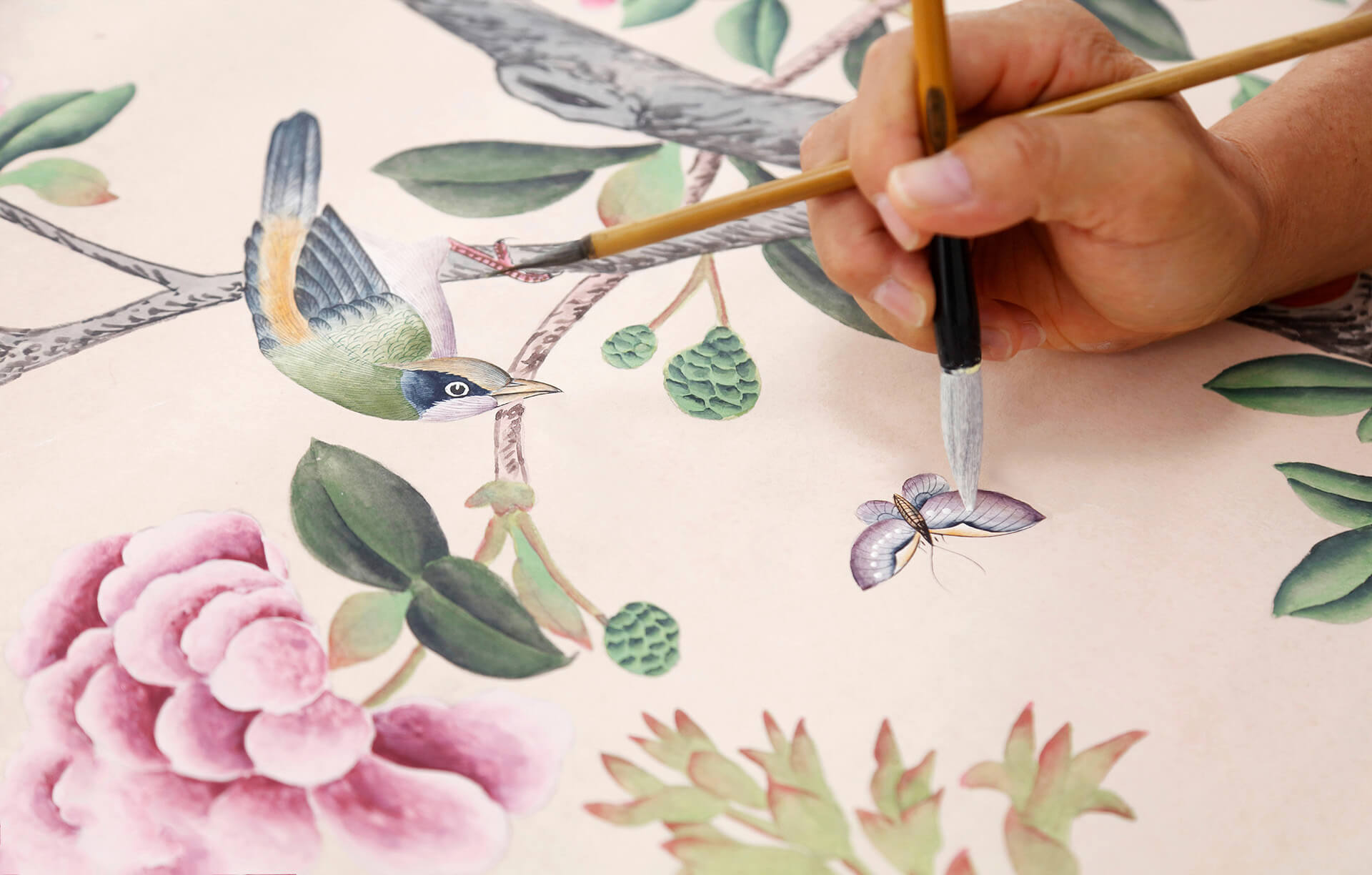Why there’s nothing else quite like De Gournay
Flamingoes in the bathroom, an African savanna in the bedroom, and a Coromandel screen in the sitting room: de Gournay’s handpainted wallpapers can transport you to far flung places in the comfort of your own home. Aimee Farrell goes exploring

“Wallpaper is so powerful in decoration,” says Hannah Cecil Gurney. “It completely envelops you when you walk into a room, setting the mood and making you feel as though you’re worlds away. That’s a magical thing; a home should be a sanctuary.”
As one of the quartet of directors at the venerated hand-painted wallpaper maker, de Gournay, she should know. Growing up, Cecil Gurney and her sister, Rachel, were immersed in this richly decorative tradition. “There were wallpapers absolutely everywhere,” she says. “Our whole house was my father’s testing ground.”
Cecil Gurney’s earliest memories are of skipping down the stairs past a papered scene portraying everyday Chinese life in vivid pictorial detail, to the company’s original basement office and showroom. Much has changed since her father, Claud Cecil Gurney, first founded the firm in the early 1980s while still working in finance. “He’s a visionary,” she says of her father, “but he also has the ability to get things done.” Now in his seventies, he shows no sign of slowing down. “I can’t keep up with him,” she admits.
What began with reproductions of antique wallpaper for historic houses has burgeoned into a global business creating original and custom papers. “We soon realised these designs worked just as well in modern penthouses or London townhouses as they did in stately homes,” she says.
A case in point is Cecil Gurney’s own Battersea house, an imaginative playground of de Gournay’s scenic papers. Shared with her husband, Eddie Harden, their six-year-old son, George, and three-year-old twins, Oscar and Scarlet – and imminently, their fourth child – it’s a testament to the power of wallpaper to transport an interior beyond the humdrum.
There are flamingoes in the bathroom, an exotic scene of an African savanna in the bedroom, and bold, chocolatey floral chinoiserie inspired by a Coromandel screen from the apartment of Coco Chanel in the sitting room. Most of the walls feature custom designs, including in the children’s bathroom, which borrows from the childlike drawings of the Bemelmans Bar in New York’s Carlyle Hotel.
It’s the tailor-made side of the business that’s fuelling de Gournay’s growth, with the in-house design team expanding in recent years to meet the growing demands of this bespoke boom.
Despite the global scope and reputation of the brand, and an increasingly diversified workforce, de Gournay remains a small, tight-knit, family-owned business. “We call it chaotic anarchy,” says Cecil Gurney of the eccentric ethos that continues to fuel the operation. “We’re all very independent and have our own ideas and dreams, and are constantly running in different directions – but somehow it works.”


DREAM DUOS
De Gournay’s greatest collaborative hits
With a sweep of inventive collaborations, de Gournay keeps things fresh. Here’s our potted history of some of the best:
Aquazzura, 2018
The Florentine footwear atelier – which celebrates its 10th anniversary this year – worked with de Gournay on a collection of chinoiserie clad shoes. The one-of-a-kind rainforest design also became a paper which transformed Aquazzura’s Milan store into a decadent jungle.
Erdem, 2020
Erdem Moralioğlu united fashion and interiors – the London designer conjured an Eden-like line of wallpapers featuring birds and blooms, and three capsule collections of clothes, which Hannah Cecil Gurney calls “a modern celebration of romance and femininity”.
India Mahdavi, 2020
Inspired by the miniature paintings of the 16th-century Persian artist Reza Abbãsi, the Parisian designer and so-called “queen of colour,” India Mahdavi, created a dreamlike, pictorial scene in evocative tints of lilac and powder blue. This was put up in the private apartments at de Gournay’s Paris showroom, alongside a bold geometric orange design that brought slick, modernist lines to the company’s papers.
Houghton Hall, 2018
It was something of a revelation when Rose Hanbury, the Marchioness of Cholmondeley, discovered an original cache of 18th-century wallpaper in her attic. It matched the much-faded decor of the Cabinet Room at Houghton Hall in Norfolk, and ignited a rich collaboration which gave rise both to a reproduction of the brightly hued attic originals and an entirely new design which covers her bathroom walls and feels, she says, “incredibly spoiling.”
People love to think wallpaper is coming in and out of fashion. But wallpapers are more like artworks – they never go out of style

De Gournay has showrooms in seven cities spanning from London and Paris to Beirut, which serves as a gateway to the Middle East. There is an office and embroidery studio in a restored Indian courtyard house in Calcutta, and plans for a new showroom in Mexico City. De Gournay have also focused on their digital presence, hiring their own in-house videographer and photographer, enabling their aesthetic to be communicated across the globe.
The brand’s international appeal is a reflection of wider shifts in taste; luxury today is all about the unique, the one-off and the handmade. “More and more, people want wallpaper that reflects their culture, their history, their story,” says Cecil Gurney. “People fall in love with the idea that they can have something tailored for them just like a couture gown. When it comes to the de Gournay designs, the sky’s the limit. ”
More than simply repeated patterns on walls, de Gournay paper comes in panels of 91.5cm x 150cm-350cm, each taking around 120 hours to be hand-painted in watercolour at their studio in Wuxi, close to Shanghai. Merging precision with artisanship, these slow-spun papers are formed with the same care as a painter’s canvas. Barring major disasters, they’re designed to last for hundreds of years – something truly refreshing in a throwaway age. The bespoke nature of the business also means that there is little wastage. The company’s focus now is on developing organic materials and chemical-free dyes that will stand the test of time. With this in mind, plans to develop an in-house weaving studio are in the works.
For Rose Hanbury, the Marchioness of Cholmondeley, who collaborated with the company on a historical paper for Houghton Hall in Norfolk in 2018, the joy of de Gournay is in its human scale. “It wasn’t like dealing with this huge corporation,” she says. “They’re these incredible talents who made the whole process of creating the wall coverings really pleasurable and fun.”
The project revolved around the recreation of an oriental garden pattern that was first hung in Houghton Hall’s Cabinet Room in 1769, as well as a brand new design. “So much is done digitally now, it’s wonderful to have these handworked papers, but as well as keeping a tradition going, they’ve managed to stay current,” says the Marchioness. Houghton Hall’s papers mark one of a sweep of highly creative collaborations, including projects with fashion labels like Erdem, Aquazzura and Parisian interior decorator India Mahdavi – the woman who painted Sketch millennial pink.
Cecil Gurney’s father’s original vision certainly answered a need. Before de Gournay no-one else was creating historical reproductions in Britain. “My father has a natural flair for decoration,” she explains. “He’s often eccentric in his choices, and constantly hungry for knowledge.” When his role in finance took him to Paris for close to a decade, he filled his spare moments immersing himself in European decoration, touring the chateaus and castles of rural France. Today, de Gournay papers continue to be in demand with decorators, to be found adorning the likes of Cartier’s global stores and the revamped Annabel’s nightclub in London’s Mayfair.
Cecil Gurney balks at the idea that papered walls might simply be having a moment in vogue. “People love to think that wallpaper is coming in and out of fashion,” she says. “But in fact, de Gournay creations are more like works of art – they never go out of style.”
Aimee Farrell is a consultant specialising in visual arts, interiors and design. She is a contributing editor to FT HTSI and regularly contributes to T Magazine and British Vogue

